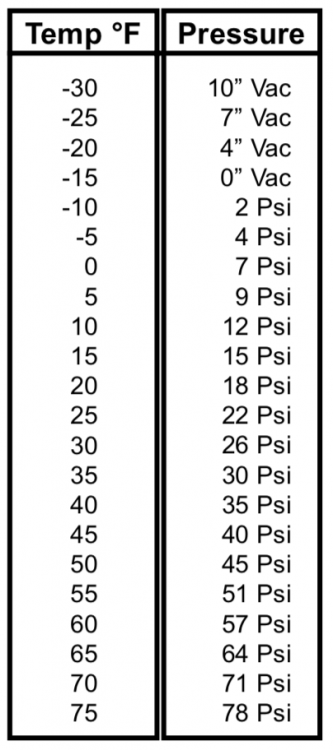Why You Can't Troubleshoot a Sealed System Without Knowing Thermodynamics
You can't get around it -- you've got to understand at least the basics of thermodynamics to troubleshoot sealed system problems.
Let's say you're working on a two-compressor R134a refrigerator -- completely separate sealed systems for the freezer and the fresh food compartment. Two evaporators, two compressors... you get the idea. You're experiencing an issue where the FF is always too cold. Say, 20F or so. All the other components seem to be in spec, so you put a gauge on the low side of the FF sealed system. It reads 5 psig.
What does that reading tell you about the sealed system? You have two ways of finding out: look at the specs, or know your thermodynamics. Ideally, you'll do both.
Let's look at the specs first. You pull up the service manual and see this chart:
5 psi is barely within the given range for the refrigerator, and what's more, it's within the upper range for a freezer evaporator! That right there should tell you something is up. But without knowing anything about thermodynamics, you still don't know exactly what that 5 psi means.
A refrigerant's saturation temperature -- the temperature at which it begins boiling -- is a direct function of its pressure. Higher pressure means a higher saturation temperature, lower pressure means a lower saturation temperature. This chart illustrates this nicely:
A freezer evaporator should run at roughly -20F. Super cold! But what about a FF evaporator? A FF compartment shouldn't get nearly as cold as a freezer, so the evaporator shouldn't be as cold, either. FF evaporators typically operate at something closer to +20F.
How does all this info help us with our cold FF compartment with 5 psi in the evaporator? Well, refrigerant in the first 2/3 of an evaporator coil is at saturation. So if we know the low side pressure, we know the evaporator saturation temperature! What temperature does 5 psi correspond to? You can estimate it using that chart, or you can use the handy Danfoss refrigerant slider app on your phone like I am now (see the screenshot in the newsletter for this post)...
5 psig in an R134a system corresponds to exactly... -3.1F! That's way too cold for a FF evaporator, and it definitely explains our chilly temps. What caused this issue is most likely either an undercharge of refrigerant or a leak in the system, causing lower pressures and therefore lower saturation temps.
To sum it all up: as soon as we saw that 5 psig in the FF low side, we knew what was wrong. It's a simple data point, but interpreting it correctly required us to a) understand basic thermodynamics b) know the difference between the operating temperatures of a freezer evap and a FF evap. Not only do you need to do the right measurements and have the right specs, but you need to have the knowledge to draw the correct conclusions from them.
Want to learn more about sealed system thermodynamics? If you're a premium tech member here at Appliantology, it's right here waiting for you. Just go to the webinar recordings index page and scroll down to the 5-part series on Refrigerator Sealed System Thermodynamics. You'll learn everything you need to know.
-
.png) 8
8







1 Comment
Recommended Comments